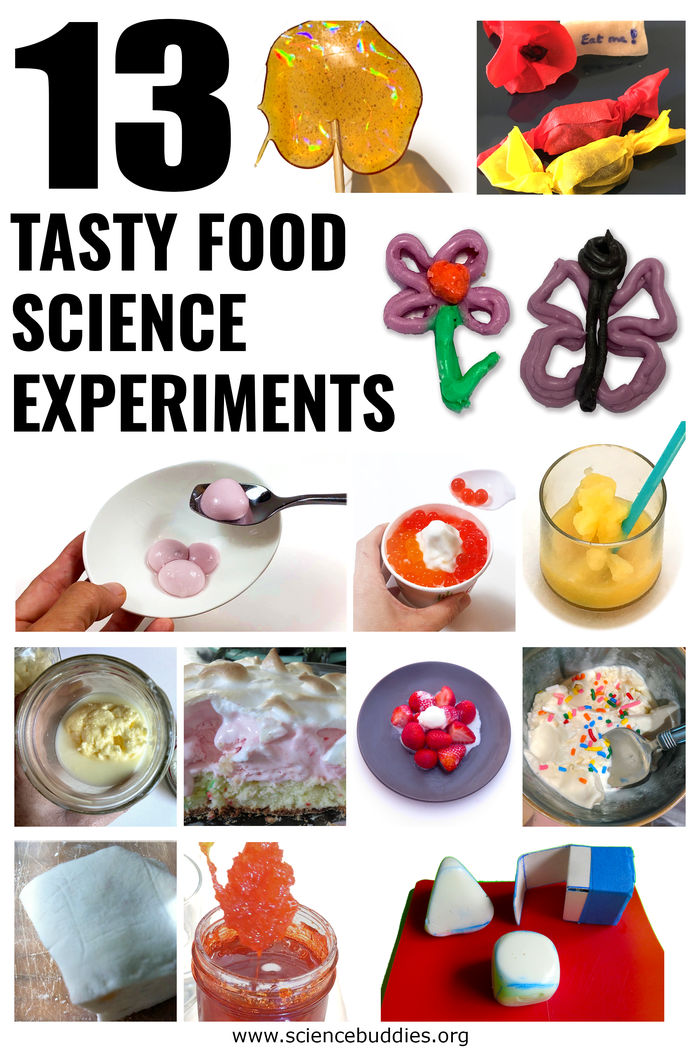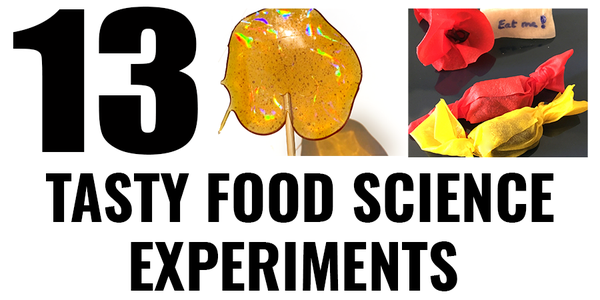13 Tasty Food Science Experiments!
These food science experiments lead to fun, unusual, and tasty creations! Try one of these STEM projects for engaging kitchen chemistry, and molecular gastronomy. There's a bit of physics and technology baked in, too!

13 Tasty Food Science Experiments!
With food science projects and experiments, students measure, mix, cook, bake, and investigate the importance of specific ingredients, the science of mixtures and solutions, and the chemical reactions that may occur when ingredients are combined, heated, shaken, or frozen. In addition to being fun for classes, afterschool, or family science at home, food science projects can work well for science fair projects and other independent student projects following the scientific method. By identifying variables and choosing specific variables to change or test, students can experiment to explore ratios, the viability of substitutions, and what customizations and changes to recipes can work.
The projects and activities highlighted below include a range of foods, some familiar and some unusual, that involve interesting science concepts or techniques. From making ice cream in a bag or shaking up butter in a jar to the molecular gastronomy involved in making juice balls (spherification) or yogurt ravioli (reverse spherification), these activities offer opportunities for mouthwatering science!
- Making and Testing Edible Rice Paper: make your own edible rice paper and experiment to see how it compares to other types of paper. (An activity is available for doing this experiment with a group or at home.)
- Rainbow Candy: use light-bending science to make this "rainbow" candy without using any food coloring!
- 3D Print with Icing: No 3D Printer Required!: use royal icing to make small objects by building up multiple layers of icing in a manner similar to how some 3D printers work.
- Make Yogurt Spheres Using Molecular Gastronomy: explore molecular gastronomy and use reverse spherification to make yogurt ravioli. How does the length of time the ravioli sits in the sodium alginate solution relate to the final texture?
- Make Popping Boba Balls Out of Your Drinks: use spherification to make boba-like juice balls. Experiment to find the amount of sodium alginate that works best to make uniform, spherical balls (rather than snakelike strings).
- Homemade Slushies: experiment with making custom flavored slushies using flavored water, juices, and resealable bags. Why do some liquids turn into slushies and others don't? What does the freezing point of the liquid have to do with the process, and what role does the ice mixture of salt and water play in how a slushy freezes?
- Shaking for Butter: it is easy to make butter (and buttermilk) by shaking heavy cream. The ingredients are simple, but does the temperature of the cream make a difference? (An activity is available for informal use.)
- Bake Your Ice Cream: discover how meringue can be used as an insulator so that the ice cream inside this unusual dessert stays frozen even after being in the oven.
- Hot Ice Cream: this unusual ice cream is solid when it is hot and melts as it cools. Investigate the role of methyl cellulose in making "hot ice cream" and experiment to see if the melting rate can be controlled by varying the recipe.
- Make Ice Cream in a Bag: shake up ice cream in a bag and find out how a salt-ice mixture helps with the freezing process! Once you have the basic recipe, see what custom flavors you can make like these students did.
- Make Your Own Marshmallows: experiment with how changing the ratio of ingredients in the recipe for marshmallows changes the consistency of the marshmallows. What's the best ratio for the chewiest or the softest marshmallows?
- Grow Rock Candy Crystals: investigate how sugar crystals grow by making homemade rock candy.
- Shaping Hard-boiled Eggs: experiment with making hard-boiled eggs in different shapes to turn ordinary ovoid eggs into something totally unexpected. What's the best process? What shapes work best? (For added inspiration, see this family's shaped eggs experiment.)
Food Science Project Videos
Watch these STEM videos to learn more about the food science projects and experiments listed above:
Related Experiments
For other kitchen chemistry and food science projects and experiments for K-12 students, see:
See also, 13 Lessons to Teach About the Chemistry of Mixtures and Solutions.
Categories:
You Might Also Enjoy These Related Posts:
- Teach Genetics and Heredity with Free STEM Lessons & Activities - Genetics Science Projects
- Star Wars Projects for May the 4th Be With You Science
- 25+ Earth Day Science Experiments and Activities
- Arduino Science Projects and Physical Computing
- Spring Science Projects: 26 Science Experiments for Spring
- 25+ Robotics Projects, Lessons, and Activities
- March Madness Basketball Science Projects: Sports Science Experiments
- 15 Density Science Experiments



















